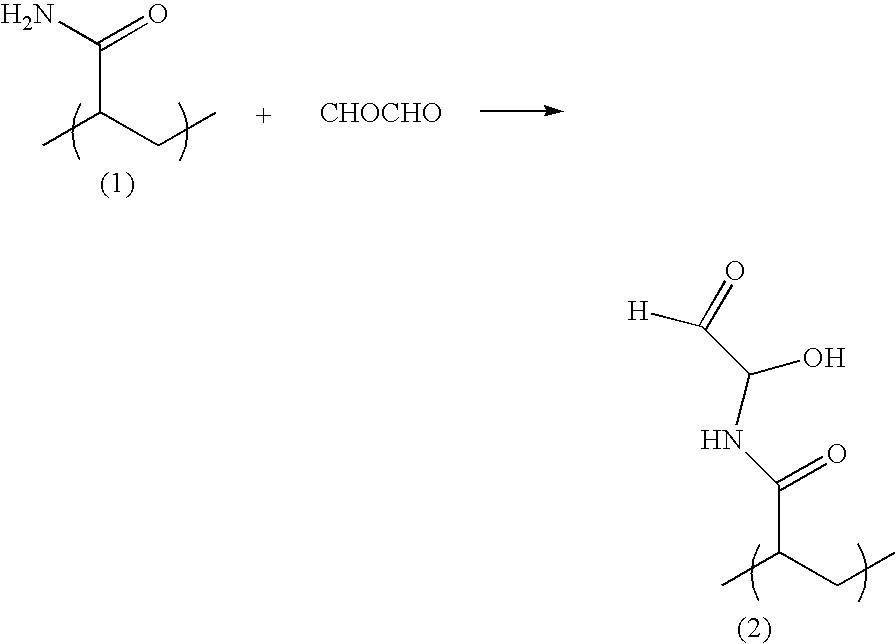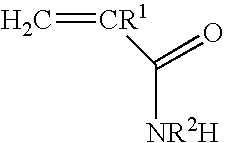Blends of glyoxalated polyacrylamides and paper strengthening agents
a technology of glyoxalated polyacrylamide and paper strengthening agent, which is applied in the field of paper strengthening agent, can solve the problems of poor wet strength, poor paper quality, and rapid loss of strength of paper products made from untreated cellulose fibers
- Summary
- Abstract
- Description
- Claims
- Application Information
AI Technical Summary
Benefits of technology
Problems solved by technology
Method used
Image
Examples
example 1
Base Polymer Synthesis
[0087]A suitable 2 liter glass reactor was fitted with a stirring apparatus, thermometer, a nitrogen inlet, a condenser and then placed in a heating bath. The reactor was charged with 370 g of water, 190 g of a base acrylamide solution (50% concentration), 0.9 g of N,N′-methylene bisacrylamide, 11 g of 2-mercaptoethanol and 123 g of a DADMAC solution (63% concentration). The reactor was then heated to 80° C. at which time an additional monomer feed and the initiator solution feed were continuously and slowly added to the reactor over 145 minutes and 160 minutes respectively. The monomer feed consists of a mixture of 850 g of a base acrylamide solution (50% concentration), 4.1 g of N,N′-methylene bisacrylamide and 49 g of 2-mercaptoethanol. The initiator feed consists of a mixture of 3.2 g of ammonium persulfate and 150 g of water. After the addition of the two feed streams was completed, the temperature was maintained at 80° C. for an additional 30 minutes. To ...
example 2
Base Polymer Synthesis
[0088]The same procedure as in Example 1 was used, except the reactor was charged initially with 220 g of water, 196 g of an acrylamide solution (50% concentration), 4 g of 2-mercaptoethanol and 120 g of a DADMAC solution (63% concentration). The reactor was then heated to 80° C. at which time the monomer feed and the initiator solution feed were continuously and slowly added to the reactor over 145 minutes and 160 minutes respectively. In this case, the monomer feed consists of a mixture of 800 g of an acrylamide solution (50% concentration) and 16 g of 2-mercaptoethanol. The initiator feed consists of a mixture of 5.0 g of ammonium persulfate and 150 g water. The final solution has a solids concentration of 44%, a pH of 3.2 and a viscosity of 175 cPs at 25° C.
example 3
Base Polymer Synthesis
[0089]The same procedure as in Example 1 and 2 was used. The reactor was charged initially with 370 g of water, 190 g of a base acrylamide solution (50% concentration), 0.9 g of N,N′-methylene bisacrylamide, and 11 g of 2-mercaptoethanol. The reactor was then heated to 80° C. at which time the monomer feed and the initiator solution feed were continuously and slowly added to the reactor over 145 minutes and 160 minutes respectively. The monomer feed consists of a mixture of 850 g of an acrylamide solution (50% concentration), 4.1 g of N,N′-methylene bisacrylamide and 49 g of 2-mercaptoethanol. The initiator feed consists of a mixture of 3.2 g of ammonium persulfate and 150 g of water. After the 60-minute addition time, 123 g of a DADMAC solution (63% concentration) was quickly charged in one shot. After the monomer and initiator additions were completed, the temperature was maintained at 80° C. for an additional 30 minutes. To lower the un-reacted acrylamide co...
PUM
| Property | Measurement | Unit |
|---|---|---|
| weight percent | aaaaa | aaaaa |
| weight percent | aaaaa | aaaaa |
| temperature | aaaaa | aaaaa |
Abstract
Description
Claims
Application Information
 Login to View More
Login to View More - R&D
- Intellectual Property
- Life Sciences
- Materials
- Tech Scout
- Unparalleled Data Quality
- Higher Quality Content
- 60% Fewer Hallucinations
Browse by: Latest US Patents, China's latest patents, Technical Efficacy Thesaurus, Application Domain, Technology Topic, Popular Technical Reports.
© 2025 PatSnap. All rights reserved.Legal|Privacy policy|Modern Slavery Act Transparency Statement|Sitemap|About US| Contact US: help@patsnap.com



